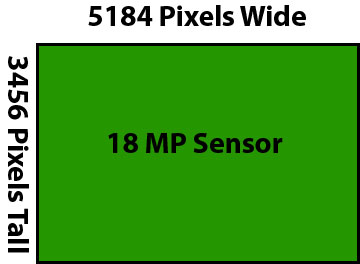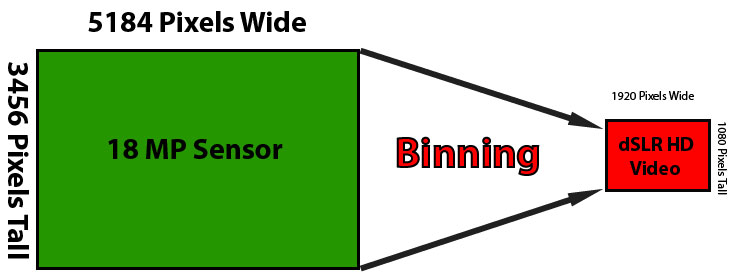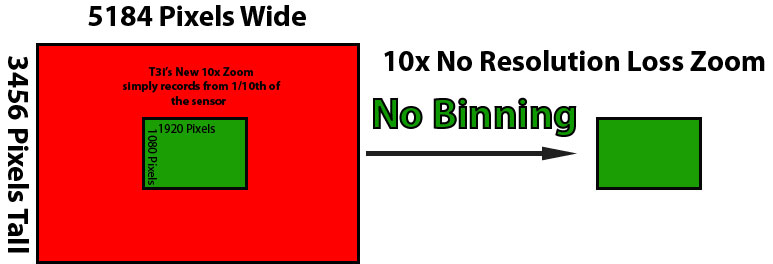The T3i sports a very interesting new video recording mode that is able to record at 10x Zoom Magnification while still maintaining HD quality (a little different meaning than ‘without the loss of resolution’). In a few previous models, there has been a 10x Digital Zoom, which was essentially a gimmick and looked awful. I have read a few forums and boards that are wondering how in the world you can zoom in 10 times and not lose any resolution (which may or may not be what they are saying).
Let me point out that Canon is somewhat cryptic in their description of this feature:
‘You can also reach distant subjects using new Movie Digital Zoom function, which crops the centre of the sensor from 3x to 10x while still maintaining Full HD quality – great for capturing wildlife on a safari holiday.’
What this exactly means is open to interpretation, but for the sake of speculation, this is just one Maven’s best guess as to how this new video feature works:
Typically, when recording video with a dSLR, the entire sensor is used in the initial capture of the image, which I will color in my diagrams as green. The T3i sports a very interesting new video recording mode that is able to record at 10x Zoom Magnification while still maintaining HD quality (a little different meaning than ‘without the loss of resolution’). In a few previous models, there has been a 10x Digital Zoom, which was essentially a gimmick and looked awful. I have read a few forums and boards that are wondering how in the world you can zoom in 10 times and not lose any resolution (which may or may not be what they are saying).
Let me point out that Canon is somewhat cryptic in their description of this feature:
‘You can also reach distant subjects using new Movie Digital Zoom function, which crops the centre of the sensor from 3x to 10x while still maintaining Full HD quality – great for capturing wildlife on a safari holiday.’
What this exactly means is open to interpretation, but for the sake of speculation, this is just one Maven’s best guess as to how this new video feature works:
Typically, when recording video with a dSLR, the entire sensor is used in the initial capture of the image, which I will color in my diagrams as green.  The Sensor size of a 7D, 60D, T2i and T3i is 5184 x 3456 (w x h) pixels, or about 18 Mega Pixels. True High Def, which is 1920 x 1080 seems to suggest that a significant amount of information (more than 66%) is thrown out. (PS- It is actually much more considering the amount of processing that occurs between the light hitting the sensor and what is actually recorded).
The Sensor size of a 7D, 60D, T2i and T3i is 5184 x 3456 (w x h) pixels, or about 18 Mega Pixels. True High Def, which is 1920 x 1080 seems to suggest that a significant amount of information (more than 66%) is thrown out. (PS- It is actually much more considering the amount of processing that occurs between the light hitting the sensor and what is actually recorded).
As a side note: There are 2 ways to reduce the image size of video while recording:
1- “Line skipping” where only every third line is read, and then the footage is resampled to fit a nice HD aspect ratio.
2- “Binning” is essentially how a single pixel’s color can be determined by it’s surrounding pixels, so when that massive 5184 x 3456 image is downsized, every original pixel is used in the calculation of each and every final pixel.
I don’t really want to get on a tangent, but there is a lot of information and debate on what is kept and what is thrown out. It really depends on who you ask and who those people work for (not a jab either at Red or Canon), which isn’t the point here, just know that A LOT of info is thrown out. From what I have read and who I have talked to, I am going with Canon dSLRs are binning, not line skipping (and I realize there will be about 1000 of you who will want to argue with me on this). If you are one of these people I can refer you to some great threads on this, again, not the point of this post- substitute “line-skipping” for binning if it makes you feel better.
So up to this point, the first diagram shows how Canon Cameras have been recording video from the large sensor sizes- (I will use green to mark original sensor data and red to mark footage that has been through binning or data that is ignored altogether) I believe the new feature simply records an HD sized Square from the middle 1920 x 1080, ignoring the rest of the data. No binning or downsampling required. (Maven’s Note: the definition of how Canon is using “3x-10x” and in which feature, HD vs SD vs still not exactly clear, if they mean 10x in HD mode, I am assuming they mean 10x in terms of total sensor area, instead of linear measurement and this is speculation here because I don’t have the camera in my hands. If it is linear, it would be closer to 3x in HD mode as our reader George points out). A linear 10x Zoom for HD would have the pixel dimensions of 518 x 345, which is less than SD resolution, and there would have to be some really fancy trickery going on for this to become 1920×1080 “without resolution loss”.
I believe the new feature simply records an HD sized Square from the middle 1920 x 1080, ignoring the rest of the data. No binning or downsampling required. (Maven’s Note: the definition of how Canon is using “3x-10x” and in which feature, HD vs SD vs still not exactly clear, if they mean 10x in HD mode, I am assuming they mean 10x in terms of total sensor area, instead of linear measurement and this is speculation here because I don’t have the camera in my hands. If it is linear, it would be closer to 3x in HD mode as our reader George points out). A linear 10x Zoom for HD would have the pixel dimensions of 518 x 345, which is less than SD resolution, and there would have to be some really fancy trickery going on for this to become 1920×1080 “without resolution loss”.
 Lets Check the Math:
Lets Check the Math:
1920 x 1080 = ~2 MP
5184 x 3456= ~17.9 MP
2/17.9 = ~.112, close enough to say that it is 1/10th the size of the original sensor, which is also “essentially” a 10x Zoom. Makes perfect sense.
There is (probably) no trickeration, weird binning or compression, the new feature simply records off a smaller size part of the sensor. If anything, Canon removed a step of the processing. I am also wondering if it can record from any part of the sensor, not just the middle. I’m thinking that it shouldn’t be too hard to do this if it doesn’t already.
This is a SUPER feature, because it allows you to get 10x closer in video. Canon…great thinking! It is conceivable that the image quality from this new wrinkle may even look better than”binned” video, but we just wont know until we see some footage. Where’s the amazing test footage Vincent Laforet?!?
I am excited to test this out and see how it looks- Ill see if I can get one of the first models out in March.















u make it really very simple with the diagram.. Michael the real maven! u rock!
But 10x zoom refers to a linear measurement does it not? If they left out the binning, it would only be a 2.7x zoom with the top and bottom cropped.
Good question- Depends on how they are measuring it – If it’s total pixel area, it’s 10x- if linear 3x. Canon touts this feature as functional in both 3x and 10x, if it’s linear, that would explain the 3x, and the 10x will look AWFUL because they will have to "create new pixels", as linear 10x would far exceed the cameras pixel ability.